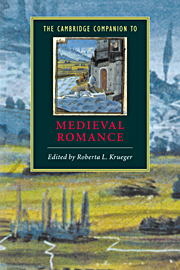Book contents
- Frontmatter
- Introduction
- Part 1 The origins, forms, and contexts of medieval romance
- Part 2 European romance and medieval society
- 5 Courts, clerks, and courtly love
- 6 The societal role of chivalry in romance
- 7 The other worlds of romance
- 8 Questions of gender in Old French courtly romance
- 9 Women and men in late medieval English romance
- Part 3 European transformations
- Editions and translations
- Index
- Series list
9 - Women and men in late medieval English romance
from Part 2 - European romance and medieval society
Published online by Cambridge University Press: 28 May 2006
- Frontmatter
- Introduction
- Part 1 The origins, forms, and contexts of medieval romance
- Part 2 European romance and medieval society
- 5 Courts, clerks, and courtly love
- 6 The societal role of chivalry in romance
- 7 The other worlds of romance
- 8 Questions of gender in Old French courtly romance
- 9 Women and men in late medieval English romance
- Part 3 European transformations
- Editions and translations
- Index
- Series list
Summary
“For al so siker as In principio Mulier est hominis confusio - Madame, the sentence of this Latyn is Womman is mannes joye and al his blis.” )
Chaucer, The Nun’s Priest’s Tale (vii, 3163-66When Chauntecleer, a cocky cock, but clearly no Latinist, woos Dame Pertelote with this paltry pick-up line, the only connection he is making between women and romance involves what he hopes will happen once he gets her off her perch. The Nun’s Priest, however, makes this connection explicit fifty lines later when he ironically asserts the improbable veracity of his mock heroic beast fable: “This storie is also trewe, I undertake, / As is the booke of Launcelot de Lake, / That wommen holde in greet reverence” (CT, vii. 3211-13). The dense irony, humor, and ambiguity of The Nun’s Priest’s Tale make it hard to tell where the narrator (let alone Chaucer) stands on women and/or romance (or on anything else, for that matter). One thing, however, is clear: women have been a confusion to men since the beginning (“In principio”), but, as Chauntecleer’s mistranslation indicates, they have also been a significant source of men’s joy, a confusing state of affairs, to say the least. One way to handle the confusio, however, is to trivialize women or to try to dismiss them.
This strategy appears in the romances of the three best-known writers in Middle English: the Gawain-poet, Geoffrey Chaucer, and Sir Thomas Malory. That students of medieval English literature have most likely read these authors’ romances is reason enough to examine them together. What is more, their writings span the hundred or so years that ranged from the mid-fourteenth through the mid-fifteenth century: the period roughly coincident with England’s Hundred Years War with France as well as with a flourishing of English literature often attributed to the rise in nationalism and the growing interest in English as an official language inspired by that war.
- Type
- Chapter
- Information
- The Cambridge Companion to Medieval Romance , pp. 150 - 164Publisher: Cambridge University PressPrint publication year: 2000
- 1
- Cited by



